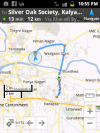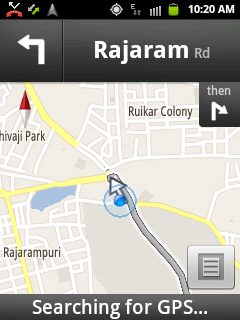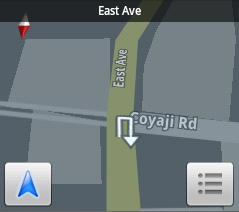 Three days ago, Google announced turn-by-turn navigation with voice assistance on the Android version of its Maps app for the top six cities in India including Pune in Western India. While driving back to my house in NE Pune from my parents’ house in SE Pune earlier tonight, I got the chance to try out the app. This was on an entry-level smartphone (Samsung Galaxy Y, BTW).
Three days ago, Google announced turn-by-turn navigation with voice assistance on the Android version of its Maps app for the top six cities in India including Pune in Western India. While driving back to my house in NE Pune from my parents’ house in SE Pune earlier tonight, I got the chance to try out the app. This was on an entry-level smartphone (Samsung Galaxy Y, BTW).
Given below is my first impression of Google Maps Navigation:
- The route suggested by the app deviated from my usual route but was valid in and of itself. (For the uninitiated, Pune is a circular city, ergo there are more than one way to drive from Point A to Point B in the city).
- When I turned left into a side road instead of staying on the main road per the suggested route, the app sensed my deviation and worked out the alternative route – my usual one – immediately. I was relieved that the lady didn’t tell me to “take a right turn at the next intersection”. Although the first turn was due in less than a minute, the app was snappy enough to work it out and display it on time.
 All visual cues for turns were perfect although the accompanying voice instructions weren’t very audible. I made sure that my phone’s media volume was set at its maximum. I also noticed later that the app didn’t have any internal internal volume controls. This won’t bother the majority of automobile drivers on Indian roads who get by with plain-vanilla Google Maps or just by asking passesrbys on the roadside for directions. But it could seriously limit adoption of the app by the small segment of drivers who practice defensive driving and who I’d imagine form the primary target audience for this app.
All visual cues for turns were perfect although the accompanying voice instructions weren’t very audible. I made sure that my phone’s media volume was set at its maximum. I also noticed later that the app didn’t have any internal internal volume controls. This won’t bother the majority of automobile drivers on Indian roads who get by with plain-vanilla Google Maps or just by asking passesrbys on the roadside for directions. But it could seriously limit adoption of the app by the small segment of drivers who practice defensive driving and who I’d imagine form the primary target audience for this app.- For lack of any other place, I’d kept the phone in the gap between the dashboard and the windscreen. Everytime my car went over a bump on the road, the phone kept falling off. For safe use of this app, a dashboard holder for placing the phone securely is mandatory.
- My phone lost almost 60% of its battery charge during the trip that lasted less than 15 minutes. This isn’t abnormal for most phones whenever the GPS is kept on – with or without this app. You just need to make sure that, when you buy the holder, you select one that permits the phone to be charged – via a cigarette lighter charger – while it’s on the holder.
The overall experience of using Google Maps Navigation was satisfactory although sub par compared to what you’d get from a dedicated satnav system, especially as regards voice-assistance quality. But, it costs nothing.
Besides, its performance can only get better on a more powerful smartphone (I hope). This is one more reason I wish the Samsung Galaxy Ace 2 smartphone that I’ve been eyeing for a long time becomes available in India soon. It was launched in Europe at the start of the year. Although it was slated for release in India by June, it hasn’t hit the stores yet. Hope I won’t have to wait much longer before I can lay my hands on one.
 UPDATE ON 24-DEC-2012: During a recent trip to Kolhapur, I noticed that Google Maps Navigation was available in this midsize town situated in southern Maharashtra. Considering that Kolhapur is quite far from any of the six largest cities in India where Google had originally announced turn-by-turn navigation this past September, this suggests that the coverage of Google Maps has expanded rapidly since its launch three months ago. Kudos to Google!
UPDATE ON 24-DEC-2012: During a recent trip to Kolhapur, I noticed that Google Maps Navigation was available in this midsize town situated in southern Maharashtra. Considering that Kolhapur is quite far from any of the six largest cities in India where Google had originally announced turn-by-turn navigation this past September, this suggests that the coverage of Google Maps has expanded rapidly since its launch three months ago. Kudos to Google!
UPDATE DATED 8 JULY 2020:
It’s eight years after I wrote the above original post.
Re. the following point in the original post:
This won’t bother the majority of automobile drivers on Indian roads who get by with plain-vanilla Google Maps or just by asking passesrbys on the roadside for directions. But it could seriously limit adoption of the app by the small segment of drivers who practice defensive driving and who I’d imagine form the primary target audience for this app.
How wrong I was!
Google Maps is used by everyone and his dog today. Rideshare Drivers and Hyperlocal Delivery Agents who have absolutely no clue about the topography of a city are going about their business, enabled entirely by Google Maps. More at How Rideshare Startups Flipped A Switch To Create A Billion Dollar Business Overnight.
Drivers who formerly practised defensive driving are now leaving home / office on long trips with absolutely no clue about the route and totally dependent on Google Maps!
